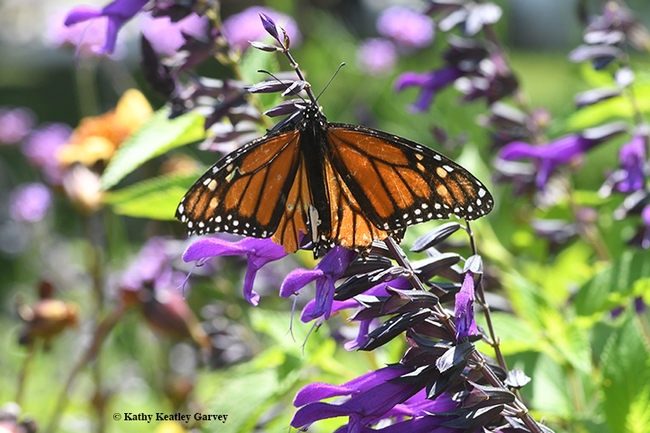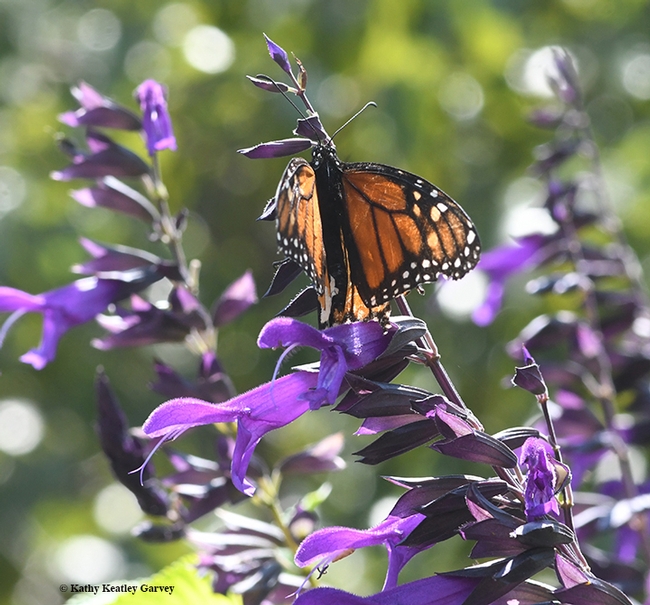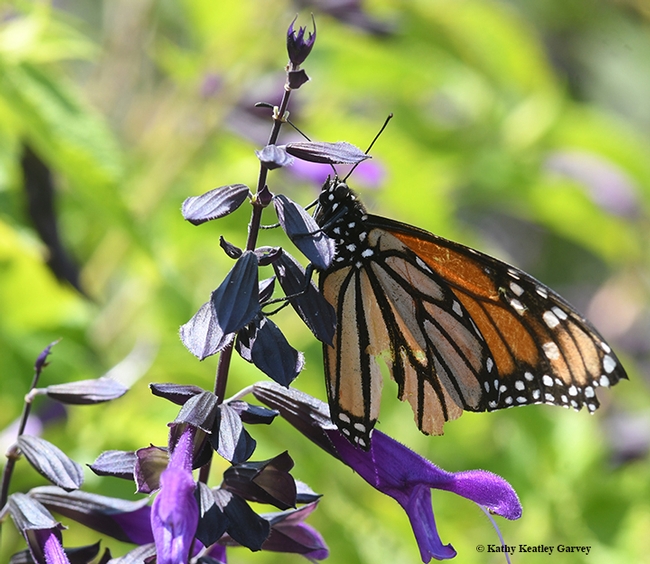- Author: Kathy Keatley Garvey
She was all bees-ness, this yellow-faced queen bumble bee, Bombus vosnesenskii.
There she was, foraging in a bed of steely blue-purple flowers, Eryngium amethystinum, a genus that belongs to the carrot family, Apiaceae.
A native bee on a non-native plant.
It was Saturday, Nov. 19 and the temperature hovered at a unseasonable 64 degrees in the Sunset Gardens, Sonoma Cornerstone, Sonoma, Calif.
Unseasonable weather and an unseasonable bumble bee.
B. vosnesenskii are spring bees, and this time of year, the queen is usually hibernating, according to the late Robbin Thorp (1933-2019), UC Davis distinguished emeritus professor of entomology and a global authority on bees. In his retirement, he co-authored Bumble Bees of North America: An Identification Guide (Princeton University, 2014) and California Bees and Blooms: A Guide for Gardeners and Naturalists (Heyday, 2014).
“Bumble bees provide an important ecological service--pollination," he told us several years before his passing. "This service is critical to reproduction of a huge diversity of plants that in turn provide shelter, food (seeds, fruits) to diverse wildlife. The potential cascade of effects from the removal of even one localized pollinator may affect us directly and indirectly.”
Professor Thorp would have loved to see this bumble bee in Sonoma. He also would have loved to know that the Bohart Museum of Entomology at UC Davis launched the annual Robbin Thorp Memorial First-Bumble-Bee-of-the-Year Contest in 2021.
Contest coordinator Lynn Kimsey, director of the Bohart Museum and a UC Davis distinguished professor of entomology, seeks the first bumble bee of the year in the two-county area of Yolo or Solano. The rules are simple: photograph it, record the time and date, and email the image to the Bohart Museum at bmuseum@ucdavis.edu.
Coincidentally, this year UC Davis doctoral candidate Maureen Page of the Neal Williams lab, UC Davis Department of Entomology and Nematology and horticulturist Ellen Zagory, retired director of public horticulture for the UC Davis Arboretum and Public Garden each took their images at exactly 2:30 p.m. on Jan. 1 in the Arboretum to share the award.
Page captured her image of B. melanopygus, considered the earliest Bombus species to emerge in this area, and Zagory, of B. vosnesenskii. (See Jan. 3, 2022 Bug Squad blog)
And fittingly, they both knew and worked with Professor Thorp.
Their prize? Each receive a coffee cup designed with the endangered Franklin's bumble bee, a bee that Thorp closely monitored in its small range at the California-Oregon border. The cup features an image of a bee specimen, photographed by Bohart scientist Brennen Dyer, and designed by UC Davis doctoral alumnus Fran Keller, professor at Folsom Lake College.
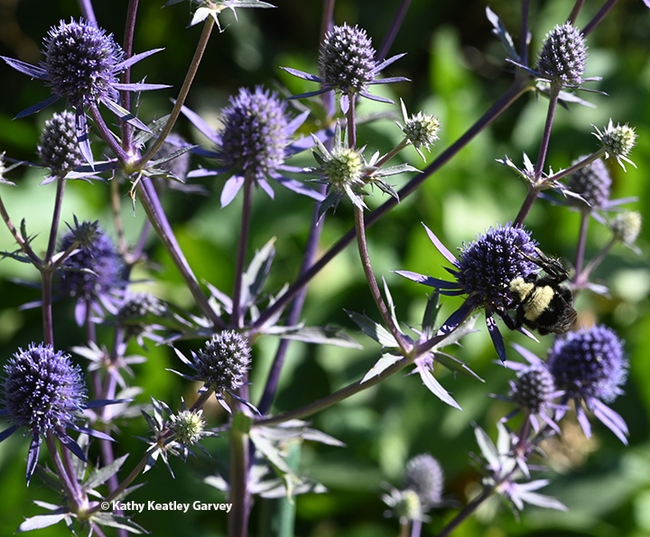
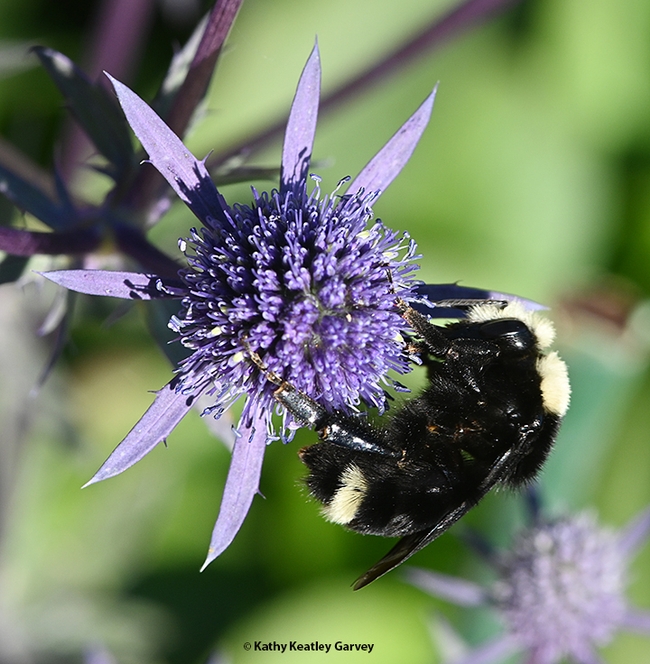
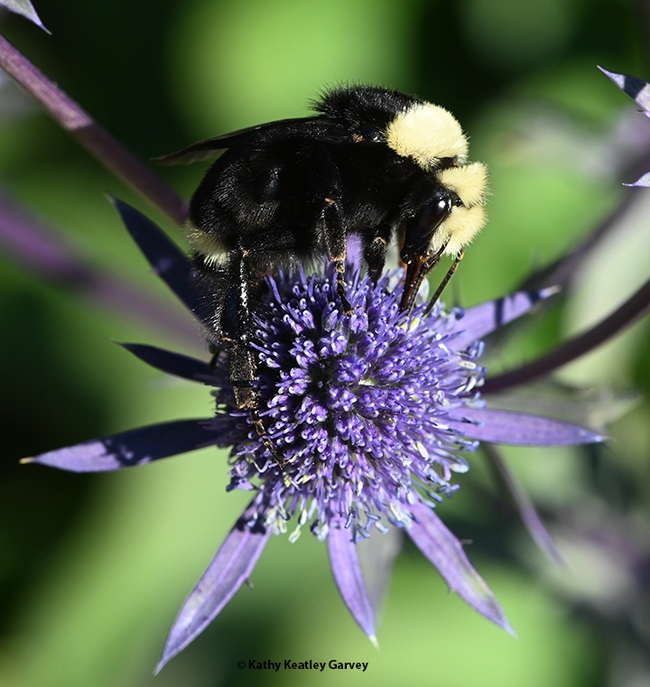
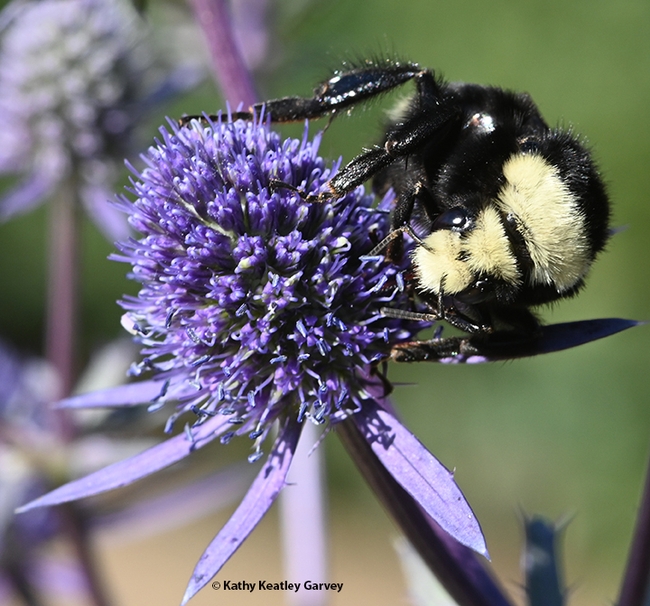
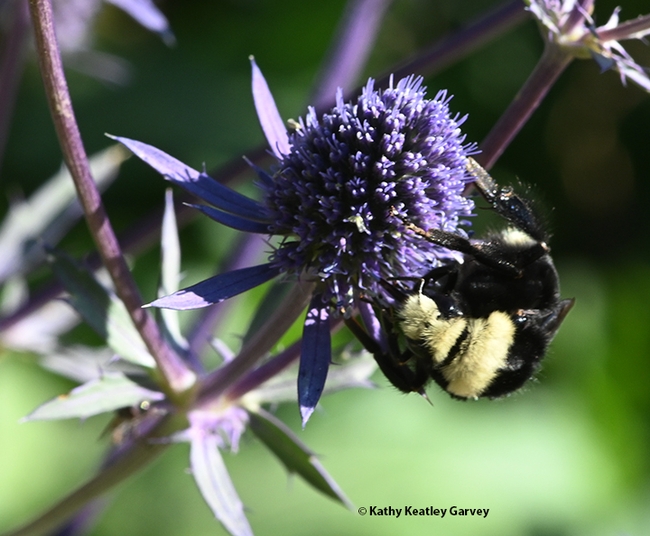
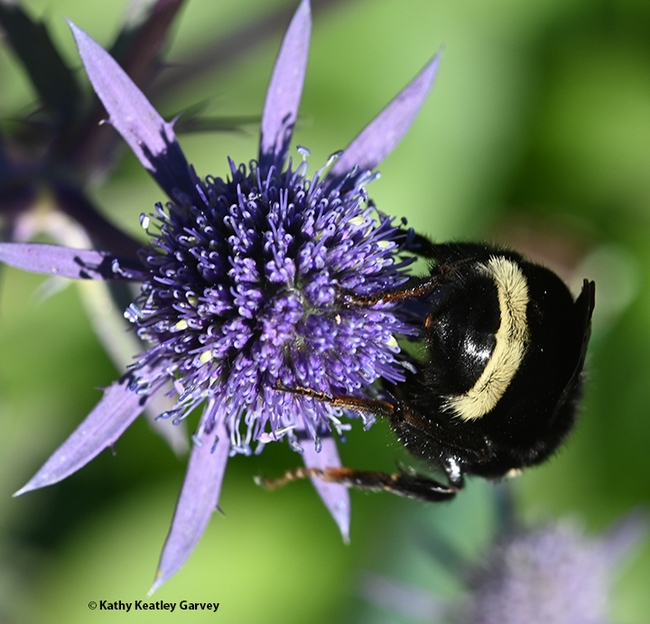
- Author: Kathy Keatley Garvey
Sometimes you just have to display your sense of humor.
Take the case of a huge praying mantis sculpture that anchors the Davis, Calif., front yard of entomologists Robert and Lynn Kimsey of the UC Davis Department of Entomology and Nematology.
It's a coronoavirus-equipped mantis, complete with gloves and a face mask.
Yes, it's well protected. Yes, it's staying home. And yes, it's keeping a safe distance and not touching its eyes, nose or mouth as it searches for prey.
The score, so far:
Praying mantis: 0; Prey, 0.
The story behind the story: Their nephew found it at a garage sale in West Sacramento last year and during the holiday season, gifted it to Bob Kimsey, a forensic entomologist and adjunct professor.
What to do with a five-foot-long, three-foot-high praying mantis?
"We dressed it up," said Lynn Kimsey, director of the Bohart Museum of Entomology and UC Davis professor of entomology.
"By next week it's going to have bunny ears and we've decided to put an empty 6-pack of Corona bottles underneath it," she said.
It resembles the praying mantis, Mantis religiosa, that we photographed at noon, Sept. 2, 2018 in the Kate Frey Pollinator Garden at the Sonoma Cornerstone, Sonoma.
We spent half an hour watching Ms. Mantis praying but not "preying" as honey bees buzzed her head.
Her appetite apparently satiated by multiple bee breakfasts consumed earlier that morning, she seemed quite content just to watch. Or maybe she was counting?
Score:
Praying Mantis: 0; Prey: 0.

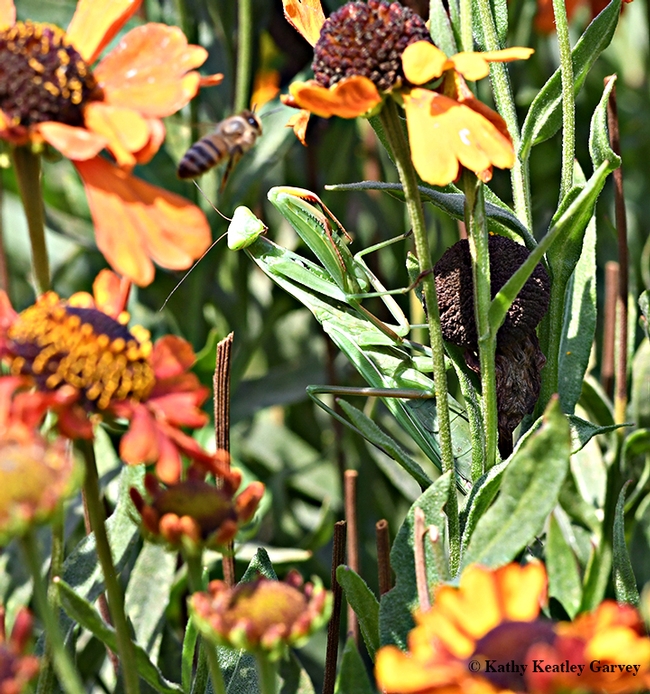
- Author: Kathy Keatley Garvey
If you visit the Kate Frey Pollinator Garden at Sonoma Cornerstone--and you should, especially during National Pollinator Week--you'll see honey bees, bumble bees, butterflies and hummingbirds, among other pollinators.
Today we spotted a male monarch patrolling the milkweed in search of a female, and a Western tiger swallowtail nectaring alternately on Verbena and on Salvia 'indigo spires.'
About that Western tiger swallowtail--it was missing a chunk of its left forewing. A predator--maybe a bird or a praying mantis--tried to nail it but missed.
About that garden--it's the work of Kate Frey, a world-class pollinator garden designer, pollinator advocate and author. When she addressed the 2018 UC Davis Bee Symposium on "Designing Bee Friendly Gardens," she said that "Bee gardens make us happy."
They do indeed.
Frey, a resident of Hopland, co-authored the award-winning book, The Bee Friendly Garden, with Professor Gretchen LeBuhn of San Francisco State University. It's a book that details how to design an abundant, flower-filled garden that nurtures bees and supports biodiversity.
And make us happy.
About that butterfly--the Western tiger swallowtail, Papilio rutulus, is common throughout western North America and is often seen in urban parks and gardens. In color, it's a striking yellow and black, with spots of blue and orange near its tail. Its wingspan can measure 3 to 4 inches.
It's "basically a species of riparian forest, where it glides majestically back and forth along the watercourse," says butterfly guru Art Shapiro, UC Davis distinguished professor of evolution and ecology on his website."It has expanded into older urban neighborhoods where several of its host genera are grown as shade trees, and behaves as if the street were a watercourse."
When we left Sonoma Cornerstone today, the "tiger" was still floating, fluttering and flittering, quite majestically, too, throughout the garden, despite the wear and tear on its left forewing.
Survival of the flittest...
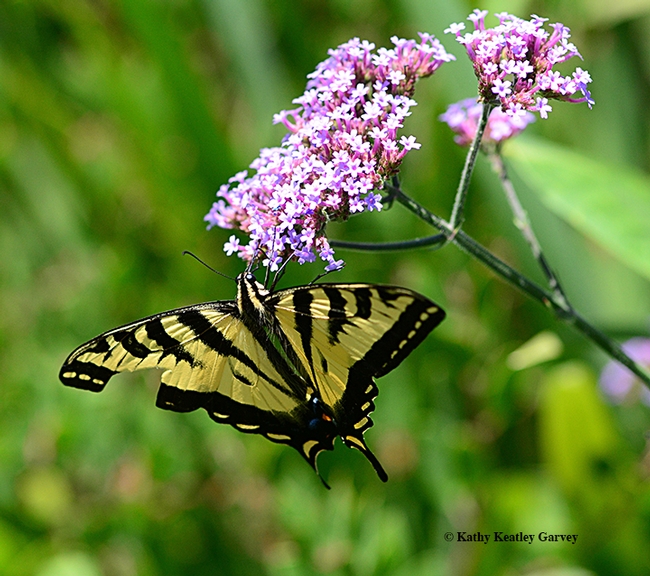
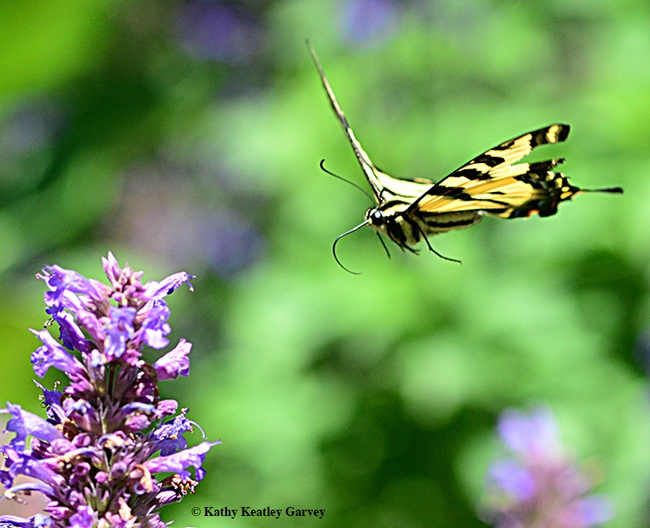
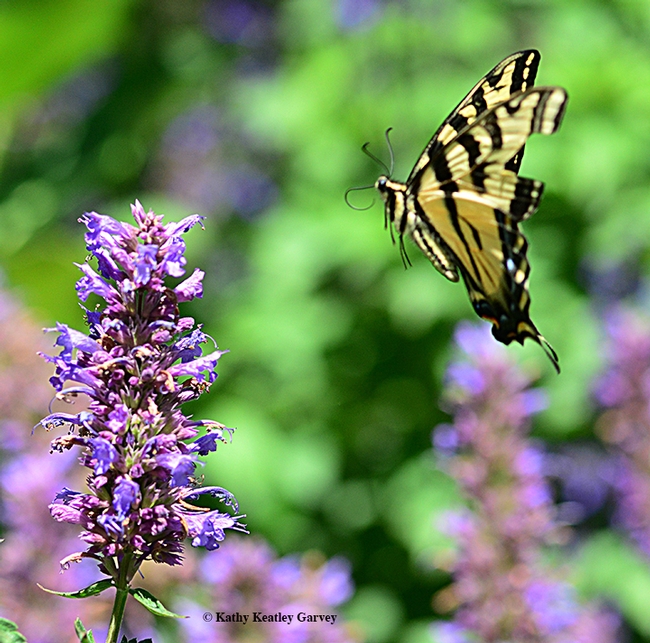
- Author: Kathy Keatley Garvey
The three men pause in front of the Kate Frey Pollinator Garden at the Sonoma Cornerstone and begin to read the sign.
"The Pollinator Garden by Kate Frey," one man reads out loud. "It's brand new, come back soon and watch as it grows. This flower-filled and colorful garden is a pollinator garden. All the plants offer food resources of pollen and nectar for pollinators such as native bees, honey bees, butterflies, hummingbirds and beneficial insects. Pollen is a protein, mineral and fat source and is primarily a larval food for bees, while nectar is composed of various sugars and is the main food for pollination and the adult life stage of many beneficial insects."
They watch the bees, butterflies and hummingbirds--buzzing, fluttering and swooshing--in a rush of colors.
"Beautiful garden," one says.
"Do you want to see a praying mantis?" I ask.
I had earlier spotted a mantis in the vegetation--a female Mantis religiosa (species identified by praying mantis expert Lohit Garikipati, a UC Davis entomology student who rears mantids).
Californians commonly see native mantids, Stagmomantis limbata and Stagmomantis californica, as well as this introduced one, M. religiosa.
"I don't see it," one of the men says. "Where is it?"
"There," I point. "Camouflaged."
"You have a good eye," he comments. "Wow, I haven't seen a praying mantis since I was a kid." He whips out his cell phone for a quick image.
The praying mantis made his day.
It's always a good day when you encounter a praying mantis.
Kate Frey, a resident of Hopland, is the author of the award-winning book, The Bee Friendly Garden, with Professor Gretchen LeBuhn of San Francisco State University, a book that details how to design an abundant, flower-filled garden that nurtures bees and supports biodiversity. She's a two-time gold medal winner at the Chelsea Flower Show and co-founder of The American Garden School. (Read this Bug Squad post to learn her favorite plants and how to attract pollinators.)
As Frey told the crowd at the 2018 UC Davis Bee Symposium, hosted last March by the UC Davis Honey and Pollination Center and the UC Davis Department of Entomology and Nematology: "Whether you plant them, nurture them, or walk through them, bee gardens make us happy."
They do, indeed. Praying mantids do, too.
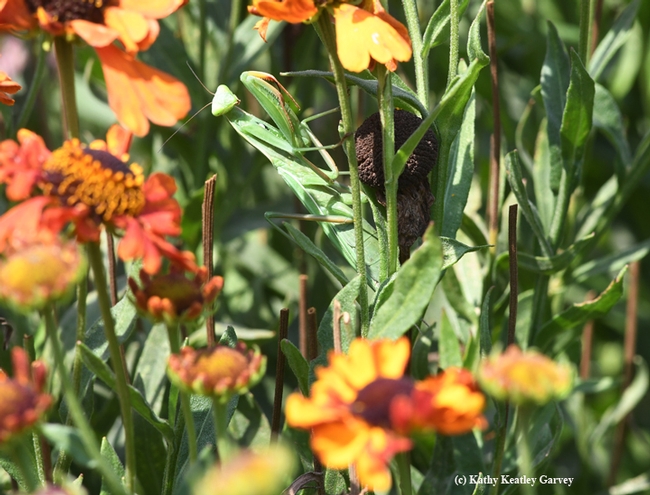
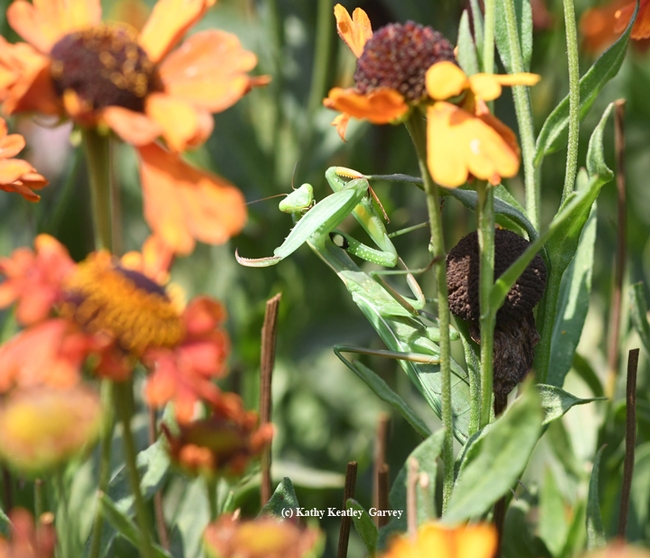
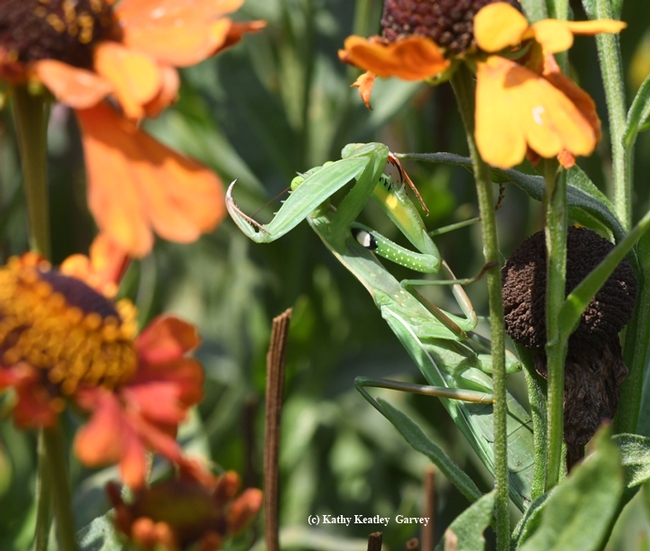
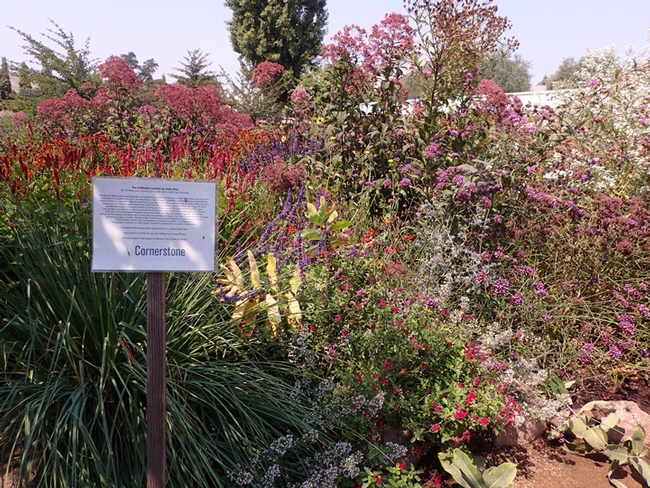
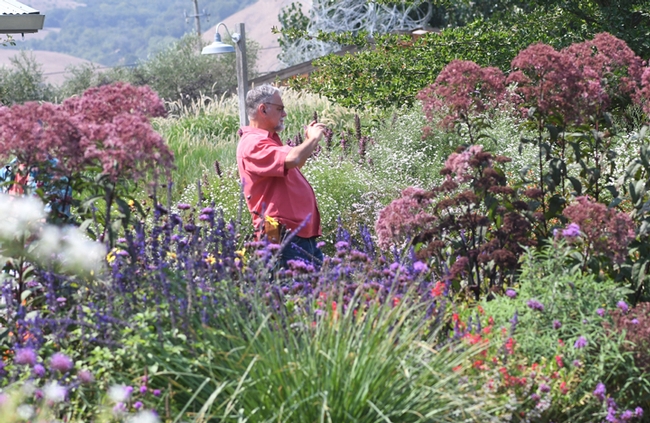
- Author: Kathy Keatley Garvey
First monarch butterfly sighting of the year.
A tattered and torn monarch--a male (as identified by Art Shapiro, distinguished professor of evolution and ecology at UC Davis) fluttered into the Kate Frey Pollinator Garden at Sonoma Cornerstone last Sunday and landed on a salvia.
He didn't move for about five minutes. Tattered, torn and tired.
His wings looked like a predator--maybe a bird or a praying mantis--tried to nab him. They did not succeed.
Usually we see monarchs around this time of year in our pollinator garden in Vacaville. The milkweed, butterfly bush and Mexican sunflowers are waiting.
Last year we saw one laying an egg on Aug. 1 on our milkweed.
This year: zero, zilch, zip here in Vacaville.
Count:
Sonoma: 1
Vacaville: 0
We remember the recent report by Xerces Society for Invertebrate Conservation that indicated the 2017 Thanksgiving Count at the monarch overwintering sites in California has decreased dramatically:
"The Xerces Society's Western Monarch Thanksgiving Count provides a long-running record of the number of monarchs overwintering in California—including the steep decline of recent decades. Volunteers and biologists who take part in the Thanksgiving Count have been invaluable in monitoring the monarch population each fall for over twenty years. Last year, another count was added with the launch of the New Year's Count—an opportunity to monitor the populations during a later period of the winter. Monarchs are mobile and they move around through the season. Combining the data from the New Year's and Thanksgiving counts allows us to better understand site and rangewide population changes. Monarch numbers at the 115 sites monitored during both of this season's counts decreased by an average of 49% between Thanksgiving and the New Year. This is similar to the change revealed by the previous New Year's Count, which saw a 43% drop at 44 sites." (See text)
As Sarina Jepsen, the endangered species program director for the Xerces Society said: “It's certainly concerning." (See more information on Project Milkweed)
